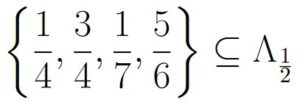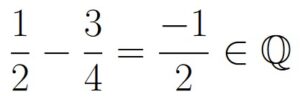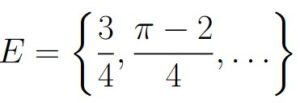Physical Address
304 North Cardinal St.
Dorchester Center, MA 02124
Physical Address
304 North Cardinal St.
Dorchester Center, MA 02124
We have seen many examples of sample spaces, and various events coming from those sample spaces. Especially when dealing with finite sample spaces, we can associate a probability with almost any subset of the sample space.
Things can get weird when dealing with infinitely large sample spaces (just as dealing with the concept of infinity can be weird at times.) Recall that an event is a subset of a sample space with which we can associate a probability. Just because we can construct a subset of a sample space, that does not mean we can necessarily associate a probability with that subset. If we are unable to associate a probability with a subset of a sample space, then that subset is not an event from that sample space.
Here, we describe one such instance of a subset of a sample space not being an event of that sample space.

Figure 1.10.1: The following argument was adapted from Saeed Ghahramani’s argument presented in the third edition of the book “Fundamentals of Probability with Stochastic Processes” which is now up to edition 4 at the time this page is published.
Consider a hypothetical experiment where you are trying to pick a real number from the interval [-1, 2]. Clearly at this point, we have that |S| = [-1, 2].
Before we continue, we’ll define an equivalence relation on the interval [0, 1] by the following:
[0, 1]: x ~ y if x – y ∈ ℚ.
Basically, what this equivalence relation is saying is that for any two numbers x and y that are both in [0, 1], we say that x is related to y (symbolically, x ~ y) if x – y is a rational number. Because we’re dealing with an equivalence relation, we can examine some specific classes to get a better handle on what we’re dealing with.
Consider the equivalence relation
[0, 1]: x ~ y if x – y ∈ ℚ.
Suppose we want to know what numbers are related to ![]() . Using the language of equivalence relations, what we want to know is what numbers in [0, 1] are in the class
. Using the language of equivalence relations, what we want to know is what numbers in [0, 1] are in the class ![]() .
.
Some simple numbers we can try are other rational numbers:

Which means that

Notice that because

this tells us that

Of course, there are infinitely many numbers that are in the class ![]() , and as such all of those classes would be equal.
, and as such all of those classes would be equal.
We can also use irrational numbers when looking for distinct classes, as in the following:

giving us that

Of course, these are two distinct classes because

This gives us that

These are just two out of many examples of distinct classes we can list.
Note that because we have an equivalence relation on [0, 1], all of the distinct classes Λα form a partition of [0, 1]. As such, we have that

The reason we defined the equivalence relation on [0, 1] was to allow us to construct a very specific kind of subset, which we can refer to as E.
Before describing the construction, remember that ℚ is countably infinite, while ℝ is uncountably infinite. This means that each of the distinct classes that arise from our equivalence relation are countably infinite in cardinality (because they are defined to be all numbers that yield a rational number when subtracted from the number used to represent the class, and the rational numbers are countably infinite.) While each distinct class from the equivalence relation is countably infinite in cardinality, the number of distinct classes is uncountably infinite in cardinality because there are uncountably infinite possible numbers we can use to specify a class.
As a quick recap, remember that the while there are uncountably infinite classes in our equivalence relation, each of those classes themselves have a countably infinite number of elements.
Now, to define our subset E, consider each of the uncountably infinite number of classes Λα defined by our equivalence relation. From each of those classes, we are going to arbitrarily pick exactly one element. Our subset E of S is going to be the set of all of those arbitrarily picked elements. The Axiom of Choice guarantees the existence of this kind of set.
We just finished describing how E is going to be constructed, so let’s see an example of how E might look.
We know that ![]() , so we could pick an arbitrary point from both of those sets to be in E. For example, we might have
, so we could pick an arbitrary point from both of those sets to be in E. For example, we might have

No other points from ![]() or
or ![]() are going to be in E.
are going to be in E.
Because there are an uncountably infinite number of classes, and E contains exactly one point from every single one of those distinct classes, E must be uncountably infinite in size. We now have a subset E that is a subset of S.
Now that we have constructed some subset E, let’s see what happens when we try to associate some kind of probability
p(E) = pE.
with E.
Let’s start by defining some new sets that are related to E. First, define ℚ[-1, 1] to be the set
ℚ[-1, 1] = [-1, 1] ∩ ℚ,
or in other words, the set of all rational numbers in [-1, 1]. The reason for defining this set is that
x ∈ Λα ∧ y ∈ Λα ⟹ x – y ∈ [-1, 1] ∩ ℚ,
and so ℚ[-1, 1] is a convenient short-hand.
Next, define En to be the set
En = { rn + x : x ∈ E }
where rn is the nth number in ℚ[-1, 1] (we can refer to the nth number in ℚ[-1, 1] since it is a subset of ℚ, a countably infinite set.) Basically, all we’re doing to define En is shifting all elements within E by some fixed amount rn, a translation. This will essentially shift the interval of numbers from [0, 1] to [0 + rn, 1 + rn]. Based on how the equivalence relation is defined on [0, 1], and how ℚ[-1, 1] was defined, we have that
[0 + rn, 1 + rn] ⊆ [-1, 2],
which is why S was defined to be the set [-1, 2] at the start of this section.
Notice that E is a set consisting of an uncountably infinite number of points in the interval [0, 1] by definition. In other words,
E ⊆ [0, 1].
Because rn ∈ ℚ[-1, 1], we also have that rn ∈ [-1, 1].
Suppose we pick r1 = -1, then
E1 = {-1 + x : x ∈ E} ⟹ E1 ⊆ [0 – 1, 1 – 1] = [-1, 0].
Next suppose by some numbering scheme we decide that r2 = -0.35, then we have that
E2 = {-0.35 + x : x ∈ E} ⟹ E2 ⊆ [0 – 0.35, 1 – 0.35] = [-0.35, 0.65].
As a final example, suppose by our numbering scheme, we have that r1 = 1. Then we have that
E3 = {1 + x : x ∈ E} ⟹ E3 ⊆ [0 + 1, 1 + 1] = [1, 2].
Notice that E1 and E3 represent the endpoints of ℚ[-1, 1], meaning for any n ∈ ℕ, we have that
En = {rn + x : x ∈ E} ⟹ En ⊆ [0 + rn, 1 + rn] = [-1, 2].
Because we’re assuming E is an event, we are also assuming that for all n ∈ ℕ, En is also an event. Furthermore, since En is a translation of E, we have that
p(En) = p(E) = pE.
Now that we have defined a family of events that are all equally likely to occur, we can examine the consequences of defining E the way we did under the assumption that it is indeed an event (and thus has a probability.) Remember, in order for a subset to have a probability, we must satisfy the three axioms of probability theory.
We make two observations.
For any two distinct points x, y in E, we have that x – y ∉ ℚ. This is because all points from E come from distinct classes from the equivalence relation defined earlier. As such x + rn ≠ y, no matter which n is chosen.
This means that for all n ≠ m, we have that x + rn ≠ y + rm. This means that
x ∈ En ⟺ x ∉ Em.
Therefore, En ∩ Em = ∅ whenever n ≠ m.

Suppose we pick some x ∈ [0, 1].
By definition of E, there must then exist some y ∈ E such that x ~ y. By the equivalence relation defined earlier, this then means that x – y ∈ ℚ[-1, 1].
Put another way, there exists some n such that
x – y = rn ⟹ x = y + rn ⟹ x ∈ En ⟹ x ∈  .
.
To recap, we’ve just shown that
x ∈ [0, 1] ⟹ x ∈  .
.
This tells us that
[0, 1] ⊆  .
.
Finally, note that because the interval [0, 1] has a length that is 1/3 of the length of [-1, 2], combining observations 1 and 2 together with Axiom 1 and Axiom 3 gives us the following:

But, if we add the same number pE ∈ [0, 1] to itself infinitely many times, the infinite sum is either 0 or ∞ (we know that if pE is the probability of E occurring, then by the axioms of probability, we would have to have pE ∈ [0, 1].)
This means that our original assumption that E is an event lead to a contradiction with the axioms of probability. Hence E must not be an event.